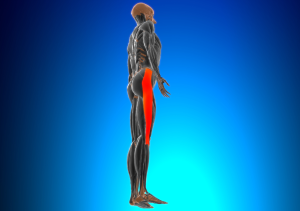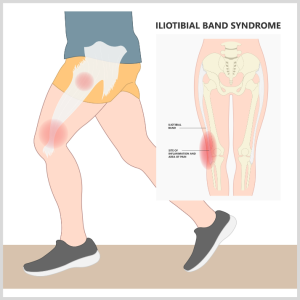Knee injuries are one of the most common types of orthopaedic injuries, affecting people of all ages and activity levels. In fact, studies show that knee pain limits mobility and impairs the quality of life in around 25% of adults. Furthermore, one of the most common knee injuries, especially among athletes, is iliotibial band (IT band) syndrome. Though we don’t know the exact number of people who have IT band syndrome, experts estimate that it makes up nearly 15% of all running and cycling injuries.
Learn all about IT band syndrome, including its causes, symptoms, treatments, and much more in the following post.
 What is the IT band?
What is the IT band?
The iliotibial band (iliotibial tract) is a thick band of fibrous tissue (ligament) that runs along the outside of the thigh from the hip to the knee. It helps to stabilize the knee and keep it in place. Three layers of tissue make up the IT band: the superficial layer, the intermediate layer, and the deep layer. The superficial layer is the thickest. Collagen fibers make up this layer. Additionally, elastic fibers make up the intermediate layer. Finally, a mixture of collagen and elastic fibers comprise the deep layer.
The IT band connects the iliac crest (pelvic bone) to the Gerdy tubercle (bony prominence on the outside of the tibia, AKA shinbone). It helps stabilize the knee by preventing the kneecap from moving too far laterally (to the outside). Also, it helps to transmit force from the hip to the knee.
What is IT band syndrome?
IT band syndrome is a common overuse injury that occurs when the IT band becomes irritated or inflamed. Often, the IT band becomes so tight that it rubs against the thighbone causing this irritation and inflammation. Furthermore, repetitive activities that involve bending and straightening the knee, such as running, cycling, and hiking can lead to this injury.
 What are the symptoms of IT band syndrome?
What are the symptoms of IT band syndrome?
The most common symptom of IT band syndrome is pain on the outside of the knee. People with this injury typically feel pain when the knee is bent or straightened. Additionally, pain may worsen when going up or down hills or stairs. Other symptoms can include:
- Tenderness on the outside of the knee
- Pain between the hip and knee
- Swelling around the knee
- A feeling of tightness or stiffness in the knee
- Difficulty walking or running
Causes & Risk Factors
The exact cause of IT band syndrome is not fully understood. However, a combination of factors is thought to possibly impact it, including:
- Overuse: The IT band is subjected to a lot of stress during activities that involve repetitive bending and straightening of the knee. This can lead to inflammation and irritation of the band.
- Tightness: The IT band can become tight due to a lack of stretching or poor flexibility. This can increase the risk of friction and inflammation.
- Malalignment: If the knee is not aligned properly, it can put more stress on the IT band. This can increase the risk of injury.
- Female sex: IT band syndrome is more common in women than in men.
Diagnosing IT band syndrome
Typically, a doctor will diagnose IT band syndrome based on your medical history and a physical examination. The doctor will ask you about your symptoms and activities, and examine your knee for tenderness, swelling, and tightness. In some cases, the doctor may order an X-ray or MRI to rule out other possible causes of knee pain.
 Treatment
Treatment
IT band syndrome treatment depends on the severity of the injury. Typically, mild cases may be treated with rest, ice, compression, and elevation (RICE). However, more severe cases may require physical therapy or surgery.
- Rest: The first step is to rest from activities that aggravate the pain. This may mean taking a break from running, cycling, or other high-impact activities.
- Ice: Applying ice to the knee for 20 minutes at a time, several times a day, can help to reduce pain and inflammation.
- Compression: Wrapping the knee with an elastic bandage or compression sleeve can help to reduce swelling and pain.
- Elevation: Elevating the knee above the heart can help to reduce swelling and pain.
- Physical Therapy: Physical therapy can help to improve flexibility and strength in the thigh muscles. This can also help to reduce stress on the ligament and prevent further injury.
- Surgery: Surgery is rarely necessary for this injury. However, it may be considered in cases where conservative treatment has not been successful.
 Preventing IT Band Syndrome
Preventing IT Band Syndrome
Thankfully, people can often avoid injury by following a few simple steps. So, here are a few things you can do to help prevent IT band syndrome:
- Warm up before exercise. Warming up helps to prepare the muscles and tissues for activity. This can help to reduce the risk of injury.
- Stretch after exercise. Stretching helps to improve flexibility and range of motion. This can help to prevent injuries and improve recovery.
- Wear proper footwear. Wearing shoes that provide good support can help to reduce stress on the IT band.
- Gradually increase activity. If you are new to running or other high-impact activities, it is important to gradually increase your activity level. This will help to prevent injuries.
When should I talk to a doctor?
If you are experiencing knee pain, it is important to see a doctor as soon as possible. Unfortunately, untreated injuries often worsen over time and lead to more severe injuries down the road. Therefore, seeing a doctor quickly to determine the level and area of injury is vital, especially for athletes. Fortunately, IT band syndrome is a treatable condition, and with proper care, you should be able to get back to your activities pain-free.
Dr. Michael Ladouceur and Dr. Christopher Cook are both board-certified orthopedic surgeons and sports medicine and joint replacement specialists who frequently care for patients with knee injuries, including IT band syndrome.
 Dr. Christopher Cook is a Board-Certified Orthopaedic Surgeon and Sports Medicine & Joint Replacement Specialist at Advanced Ortho and Spine. He provides a full spectrum of Joint Replacement, Sports Medicine, and Shoulder & Upper Extremity services. Contact us today for more information or to request an appointment. Contact us today for more information or to request an appointment.
Dr. Christopher Cook is a Board-Certified Orthopaedic Surgeon and Sports Medicine & Joint Replacement Specialist at Advanced Ortho and Spine. He provides a full spectrum of Joint Replacement, Sports Medicine, and Shoulder & Upper Extremity services. Contact us today for more information or to request an appointment. Contact us today for more information or to request an appointment.
 Dr. Micheal LaDouceur is a Board-Certified Orthopaedic Surgeon and Sports Medicine & Joint Replacement Specialist at Advanced Ortho and Spine. He provides a full spectrum of Joint Replacement, Sports Medicine, and Shoulder & Upper Extremity services. Contact us today for more information or to request an appointment. Contact us today for more information or to request an appointment.
Dr. Micheal LaDouceur is a Board-Certified Orthopaedic Surgeon and Sports Medicine & Joint Replacement Specialist at Advanced Ortho and Spine. He provides a full spectrum of Joint Replacement, Sports Medicine, and Shoulder & Upper Extremity services. Contact us today for more information or to request an appointment. Contact us today for more information or to request an appointment.

With two locations near Nashville in Mt. Juliet and Hermitage, Advanced Ortho and Spine provides patients with high-quality, personalized care while advancing orthopaedic excellence. Contact us today to learn more or to schedule your appointment.
Disclaimer: This blog provides general information and discussions about health and related subjects. The information and other content provided in this blog, or in any linked materials, are not intended and should not be construed as medical advice, nor is the information a substitute for professional medical expertise or treatment.If you or any other person has a medical concern, you should consult with your healthcare provider or seek other professional medical treatment. Never disregard professional medical advice or delay in seeking it because of something read on this blog or in any linked materials. If you think you may have a medical emergency, call your doctor or emergency services immediately.
The opinions and views expressed on this blog and website have no relation to those of any academic, hospital, health practice, or other institution.